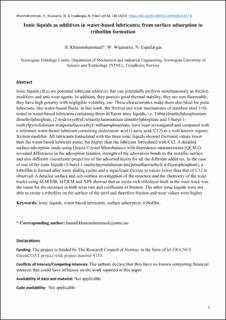| dc.description.abstract | Ionic liquids (ILs) are potential lubricant additives that can potentially perform simultaneously as friction modifiers and anti-wear agents. In addition, they possess good thermal stability, they are non-flammable, they have high polarity with negligible volatility, etc. These characteristics make them also ideal for polar lubricants, like water-based fluids. In this work, the friction and wear mechanisms of stainless steel 316L tested in water-based lubricants containing three different ionic liquids, i.e. Tributylmethylphosphonium dimethylphosphate, (2-hydroxyethyl) trimethylammonium dimethylphosphate and 1-butyl-1-methylpyrrolidinium tris(pentafluoroethyl)trifluorophosphate, have been investigated and compared with a reference water-based lubricant containing dodecanoic acid (Lauric acid, C12) as a well-known organic friction modifier. All lubricants formulated with the three ionic liquids showed frictional values lower than the water-based lubricant alone, but higher than the lubricant formulated with C12. A detailed surface adsorption study using Quartz Crystal Microbalance with Impedance measurements (QCM-I) revealed differences in the adsorption kinetics, strength of the adsorption bonds to the metallic surface and also different viscoelastic properties of the adsorbed layers for all the different additives. In the case of one of the ionic liquids (1-butyl-1-methylpyrrolidinium tris(pentafluoroethyl)trifluorophosphate), a tribofilm is formed after some sliding cycles and a significant friction to values lower than that of C12 is observed. A detailed surface and sub-surface investigation of the structure and the chemistry of the wear tracks using SEM/FIB, S(T)EM, and XPS showed that an oxide-rich tribolayer built in the wear track was the cause for the decrease in both wear rate and coefficient of friction. The other ionic liquids were not able to create a tribofilm on the surface of the steel and therefore friction and wear values were higher. | en_US |
